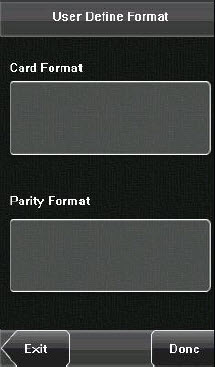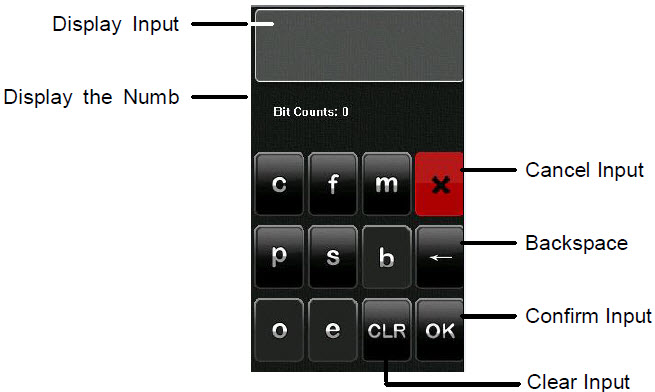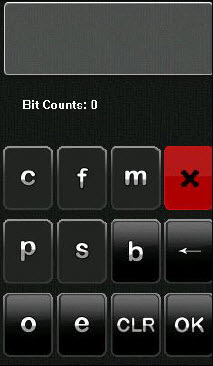5.2.3 Customized Format
Apart from the two builtin formats Wiegand 26bits and Wiegand 34bits, the system also supports the format customization function to meet individualized requirements.
The customized format consists of two character strings: the data bits and parity bits. These two character strings need to be defined separately. Data bits define the number of binary bits output by Wiegand as well as the meaning of each bit. The data bits output by Wiegand can be a card number (C), site code (s), facility code (f), manufacturer code (m) and parity bits (p). Parity bits define the check mode of each bit in data bits and ensure the correctness of data bits during transfer through the parity check. The parity bits can be set to odd check (o), even check (e) and both odd check and even check (b). There is a onetoone correspondence relationship between the data bits and parity bits.
For example, the Wiegand26 can be customized as follows:
Definition of data bits: pssssssssccccccccccccccccp
Definition of parity bits: eeeeeeeeeeeeeooooooooooooo
![]() Note: Wiegand26 consists of 26 bits. The first bit is the even parity bit of bits 2 to 13; the 26 th bit is the odd parity bit of bits 14 to 25; the second to the ninth bits are the site code; the 10 th to the 25 th bits are the card number.
Note: Wiegand26 consists of 26 bits. The first bit is the even parity bit of bits 2 to 13; the 26 th bit is the odd parity bit of bits 14 to 25; the second to the ninth bits are the site code; the 10 th to the 25 th bits are the card number.
For details about the Wiegand protocol, see Appendix 3 Introduction of Wiegand.
To customize Wiegand format, proceed as follows:
 (1) Select [Define Format] and the [Set] key is then enabled.
(1) Select [Define Format] and the [Set] key is then enabled.
(2) Press [Set] to display the [User Define Format] interface, as shown in the following figure:
(3) Click the entry box below “Card Format” to display the following interface:
 Characters used to define data bits and their meanings:
Characters used to define data bits and their meanings:
 c: Indicates the card number, that is, the output contents, it can be set to User ID/Card Number through menu operations.
c: Indicates the card number, that is, the output contents, it can be set to User ID/Card Number through menu operations.
f: Indicates the facility code which is 0 by default. It is not configurable. To modify it, please contact the equipment supplier.
m: Indicates the manufacturer code which is 0 by default. It is not configurable. To modify it, please contact the equipment supplier.
p: Indicates the parity position.
s: Indicates the site code which can be set from 0 to 255 by default.
(4) Click the entry box below “Parity Format” to display the following interface:
Characters used to define parity bits and their meanings:
o: Indicates the odd check, that is, there is an odd number of 1’s in the bit sequence (including one parity bit). For example, for 1000110(0), the parity bit is 0 and there are already three 1’s. After 0 is suffixed to 1000110, there is still an odd number of 1’s.
e: Indicates the even check, that is, there is an even number of 1’s in the bit sequence (including one parity bit). For example, for 1000110(1), the parity bit is 1 and there are already three 1’s. After 1 is suffixed to 1000110, there is an even number of 1’s.
b: Indicates both odd check and even check.
For example, Definitions of several universal Wiegand formats.
Wiegand34
Data bits: pccccccccccccccccccccccccccccccccp
Parity bits: eeeeeeeeeeeeeeeeeooooooooooooooooo
Note: Wiegand34 consists of 34 bits. The first bit is the even parity bit of bits 2 to 17; the 34 th bit is the odd parity bit of bits 18 to 33; the second to the ninth bits are the site code; the 10 th to the 25 th bits are the card number.
Wiegand37a
Data bits: pmmmmsssssssssssscccccccccccccccccccp
Parity bits: oeobeobeobeobeobeobeobeobeobeobeobeoe
Note: Wiegand37a consists of 37 bits. The first bit is the odd parity bit of bits 3, 4, 6, 7, 9, 10, 12, 13, 15, 16, 18, 19, 21, 22, 24, 25, 27, 28, 30, 31, 33, 34 and 36; the 37 th bit is the odd parity bit of bits 2, 4, 5, 7, 8, 10, 11, 13, 14, 16, 17, 19, 20, 22, 23, 25, 26, 28, 29, 31, 32, 34 and 35; bits 4, 7, 10, 13, 16, 19, 22,25, 28, 31 and 34 participate in both odd and even parity check. Bits 2 to 5 are manufacturer code; bits 6 to 17 are the site code; bits 18 to 36 are the card number.
Wiegand37
Data bits: pmmmffffffffffssssssccccccccccccccccp
Parity bits: eeeeeeeeeeeeeeeeeeooooooooooooooooooo
Note: Wiegand37 consists of 37 bits. The first bit is the even parity bit of bits 2 to 18; the 34 th bit is the odd parity bit of bits 19 to 36; the second to the fourth bits are the manufacturer code; the 5 th to the 14 th bits are facilitate code; the 15 th to the 20 th bits are the site code; the 21 st to the 36 th bits are the card number.
Wiegand50
Data bits: pssssssssssssssssccccccccccccccccccccccccccccccccp
Parity bits: eeeeeeeeeeeeeeeeeeeeeeeeeooooooooooooooooooooooooo
Note: Wiegand50 consists of 50 bits. The first bit is the even parity bit of bits 2 to 25; the 50 th bit is the odd parity bit of bits 26 to 49; the second to the 16 th bits are the site code; the 17 th to the 49 th bits are the card number.
| ย้อนกลับ | กลับสู่เมนูหลัก | ถัดไป |